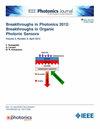Performance Analysis of IRS-Assisted Multi-Link FSO System Under Pointing Errors
IF 2.1
4区 工程技术
Q3 ENGINEERING, ELECTRICAL & ELECTRONIC
引用次数: 0
Abstract
The integration of intelligent reflecting surfaces (IRS) into free-space optical (FSO) communication systems is considered as a promising and innovative approach to overcoming existing challenges due to the strict line-of-sight (LoS) requirements faced by conventional FSO setups, thereby ensuring more flexible and controllable links and expanding the communication coverage area. Nonetheless, the configuration of IRS-assisted FSO systems remains relatively novel, requiring investigation into optimizing IRS placement to enhance system performance while mitigating interference and obstacles in dynamic environmental conditions. This work aims to evaluate the improvement of the system performance achieved through optimized IRS positioning while accounting for the main degrading factors inherent in FSO systems and IRS design. We present a comprehensive model for a multilink terrestrial IRS-assisted FSO system, taking into consideration key degrading factors such as pointing errors stemming from both transmitter and IRS jitter, IRS dimensions, and turbulence-induced fading. Furthermore, we derive closed-form expressions for the probability density function of channel coefficients, average bit error rate, and outage probability. Our results indicate that optimal IRS placement is in proximity to the transmitter, taking into account all channel impairments. Furthermore, we showed that optimal IRS placement tends to shift towards the receiver side as the IRS jitter increases. Consequently, the analysis presented offers valuable insights for efficiently designing IRS-assisted FSO systems, particularly regarding IRS placement in the presence of pointing errors.指向误差下 IRS 辅助多链路 FSO 系统的性能分析
在自由空间光学(FSO)通信系统中集成智能反射面(IRS)被认为是一种有前途的创新方法,可以克服传统 FSO 设置所面临的严格视距(LoS)要求所带来的现有挑战,从而确保更灵活、更可控的链路并扩大通信覆盖范围。尽管如此,IRS 辅助 FSO 系统的配置仍然比较新颖,需要研究如何优化 IRS 的位置,以提高系统性能,同时减轻动态环境条件下的干扰和障碍。这项工作旨在评估通过优化 IRS 定位实现的系统性能改进,同时考虑 FSO 系统和 IRS 设计中固有的主要衰减因素。我们提出了一个多链路地面 IRS 辅助 FSO 系统的综合模型,其中考虑到了主要的衰减因素,如发射机和 IRS 抖动引起的指向误差、IRS 尺寸和湍流引起的衰减。此外,我们还推导出了信道系数概率密度函数、平均误码率和中断概率的闭式表达式。我们的研究结果表明,考虑到所有信道损伤,最佳 IRS 位置应靠近发射机。此外,我们还发现,随着 IRS 抖动的增加,最佳 IRS 位置趋向于向接收器一侧移动。因此,我们所做的分析为有效设计 IRS 辅助 FSO 系统提供了宝贵的见解,特别是在存在指向误差的情况下如何放置 IRS。
本文章由计算机程序翻译,如有差异,请以英文原文为准。
求助全文
约1分钟内获得全文
求助全文
来源期刊

IEEE Photonics Journal
ENGINEERING, ELECTRICAL & ELECTRONIC-OPTICS
CiteScore
4.50
自引率
8.30%
发文量
489
审稿时长
1.4 months
期刊介绍:
Breakthroughs in the generation of light and in its control and utilization have given rise to the field of Photonics, a rapidly expanding area of science and technology with major technological and economic impact. Photonics integrates quantum electronics and optics to accelerate progress in the generation of novel photon sources and in their utilization in emerging applications at the micro and nano scales spanning from the far-infrared/THz to the x-ray region of the electromagnetic spectrum. IEEE Photonics Journal is an online-only journal dedicated to the rapid disclosure of top-quality peer-reviewed research at the forefront of all areas of photonics. Contributions addressing issues ranging from fundamental understanding to emerging technologies and applications are within the scope of the Journal. The Journal includes topics in: Photon sources from far infrared to X-rays, Photonics materials and engineered photonic structures, Integrated optics and optoelectronic, Ultrafast, attosecond, high field and short wavelength photonics, Biophotonics, including DNA photonics, Nanophotonics, Magnetophotonics, Fundamentals of light propagation and interaction; nonlinear effects, Optical data storage, Fiber optics and optical communications devices, systems, and technologies, Micro Opto Electro Mechanical Systems (MOEMS), Microwave photonics, Optical Sensors.
 求助内容:
求助内容: 应助结果提醒方式:
应助结果提醒方式:


